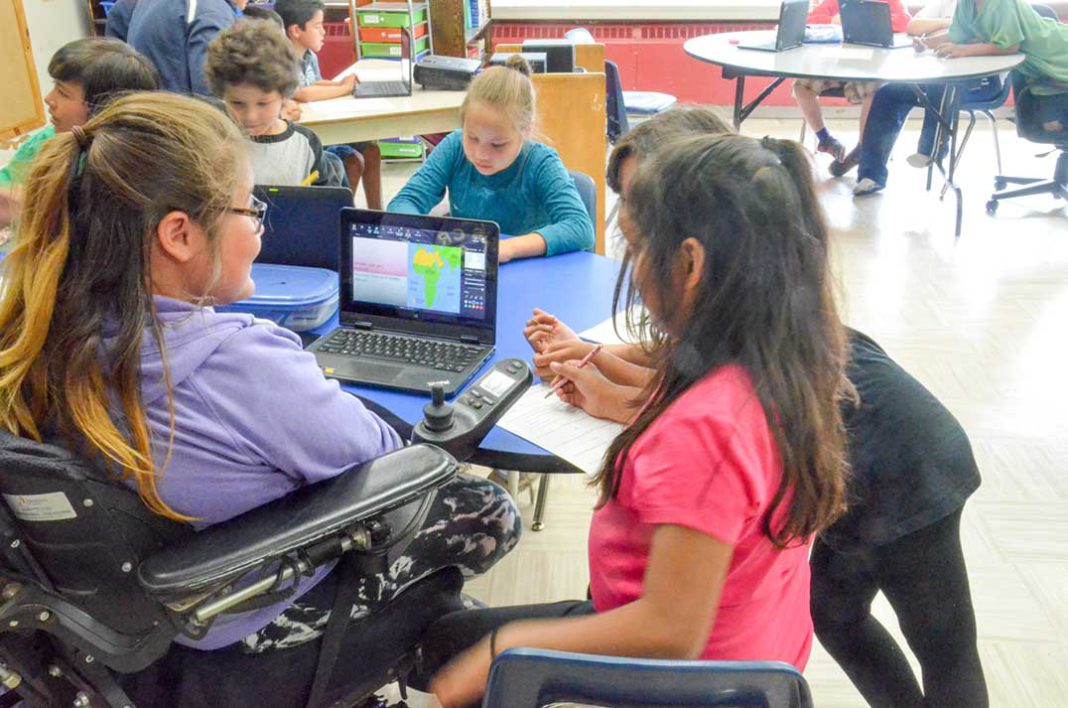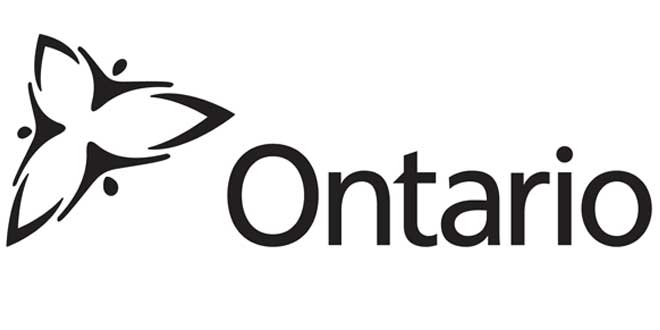WIKWEMIKONG—Take a class of Grade 6 students, mix liberally with a group of Grade 2 mentors, add a dash of technology and what do you get? A group of intensely engaged youth learning from each other as they create a series of non-fiction books targeted at the interests of the seven-year-old set.
“Engaged” is the key byword here. Stepping into Pontiac School teacher Natalie Eshkawkogan’s Grade 6 class during a group session with Wasse Abin Junior School teacher Nicole Peltier’s Grade 2 class taking part in the innovative Wireless Writing Program you are immediately struck with the focussed attention of the participants.
The Wireless Writing Program is a project that saw students from the Pontiac Grade 5 and 6 classes paired with Grade 1 and 2 students from Wasse Abin Junior School to create non-fiction books focussed on subjects that captured the imaginations of the younger students.
Pontiac Principal Mackenzie Sayers noted that the project is utilizing the Microsoft Office 365 Suite that the Wikwemikong School Board of Education (WBE) has standardized on, with most of the students creating their non-fiction books in PowerPoint.
“This program really does have the students engaged,” said Alison Biedermann, a primary learning teacher with the WBE who, along with Cathy Harley, have been working through the First Nation Student Success Program. The First Nation Student Success Program (FNSSP) is designed to support First Nation educators on reserve (Kindergarten to Grade 12) in their ongoing efforts to meet students’ needs and improve student and school results and is funded through the federal ministry of Indigenous and Northern Affairs Canada.
“The goal of the project was to have our students continue to grow as critical thinkers and create non-fiction books for a real audience,” noted Pontiac Principal Mackenzie Sayers. “Each Grade 4/5/6 classes (six in total, two at each grade level) paired up with a class at the Junior school (Grades 1, 2 and 3, two classes of each) and met with their audience during the writing process. The teachers who had their students participate as audience members included: Stephen Fox (Grade 1), Laura Hagman (Grade 1), Nicole Peltier (Grade 2), Lisa Bondy (Grade 2), Tracy Cooper (Grade 3) and Maureen Peltier (Grade 3). Our classes visited through trips to the school and also through Skype sessions.”
The pride of creation among the young students taking part in the program is impossible to miss, as Grade 6 student Isaiah Bell takes his Grade 2 colleagues Eldon Pitawanakwat and Johnathan Osawamick-Trudeau through his non-fiction book entitled ‘Savannah Cats.’ “It’s good,” pronounces Johnathan with typical Grade 2 critical brevity before turning back to the action unfolding onscreen.
Meanwhile, Brandy Jawana is going over her creation, ‘Fennec Fox.’ Brandy explains that it took her about a week to research the information and illustrations in her book from the Internet. The first phase goes back months, however, as the student authors engaged with their Grade 2 counterparts over the Internet through Skype last February to learn what subjects might interest them (the two schools are less than a half-kilometre apart physically, but the opportunity to learn about another Internet tool and the communications skills involved in finding out what interests a six- seven-year-old added different skillsets to the program). The list of subject matters contained in the works of non-fiction created by the students is as eclectic as might be expected. Arianna Recollect’s work ‘Bunnies’ contains an impressive table of contents, timelines (prominently featuring that famous cartoon icon of the genre Bugs), and boasts categories such as healthy food, toys and houses.
“Did you know that we have bunnies here that live in a hole?” asks Arianna as she explores the book with Johnathan. Maps of the globe show graphically where various bunny species can be found. With a subject matter that can be found farther afield, Autumn Peltier’s work explores the wonders of ‘Sun Bears.’
By focussing on the interests of the students and leveraging technology for its implementation, the Wireless Writing Program skillfully bounds over any elementary level barriers, creating not only technological and communication skills, but also building social connections between the age groups.
“Our June 15 festivities allowed for the authors of our non-fiction books to share their digital books with their audience and we had the students provide feedback through a form,” said Principal Sayers. “With this information each student will make revisions to their book before they go to print. We are also hoping to share our books through an internal website so that all books can be read by other classes other than the ones within the project.”
The seeds of Canada’s next great non-fiction writer could very likely be nurtured through innovative projects like the Wireless Writing Program, especially if the level of engagement is any indicator.




